Oldsmobile Cutlass Supreme 1995 s Manual PDF
Manufacturer: OLDSMOBILE, Model Year: 1995, Model line: Cutlass Supreme, Model: Oldsmobile Cutlass Supreme 1995Pages: 340, PDF Size: 16.68 MB
Page 71 of 340
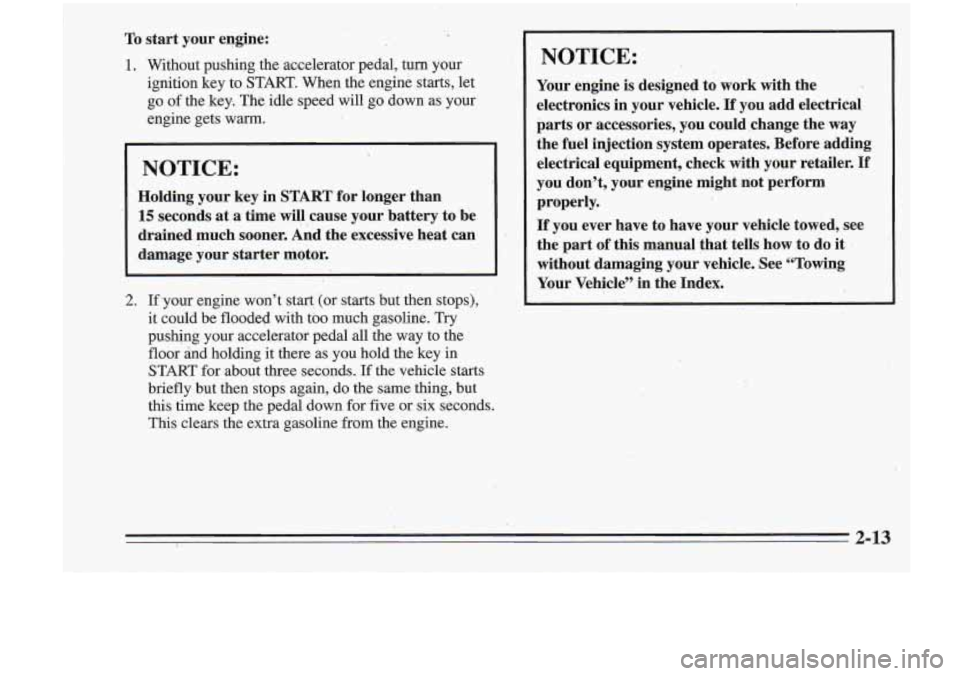
To start your engine:
1. Without pushing the accelerator pedal, turn your
ignition key to
START. When the engine starts, let
go of the key The idle speed will go down as your
engine gets warm.
NOTICE:
Holding your key in START for longer than -- 15 seconds at a time will cause your battery to be
drained much sooner. And the excessive heat can
.damage your starter motor.
2. If-your engine won’t staq (or starts but then stops),
it could be flooded with
too much gasoline. Try
pushing your accelerator pedal all the way to the
floor and holding it there as you hold the key in
START
for about three sec,onds. If the vehicle starts
briefly but then stops again, do the same thing, but
this time keep the pedal down
for five or six seconds.
This clears the extra gasoline from the engine.
I
NOTICE:
Your engine is designed to work with the .
electronics in your vehicle. If you add electrical
parts or accessories, you could,change the
way
the fuel injection system operates. Before adding
electrical equipment, check with your retailer.
If
you don’t, your engine might not perform
properly.
If you ever have to have your vehicle towed, see
the part of this manual that tells how to do
it
without damaging your vehicle. See “Towing
Your Vehicle” in the Index.
\. 2-13
.
Page 72 of 340
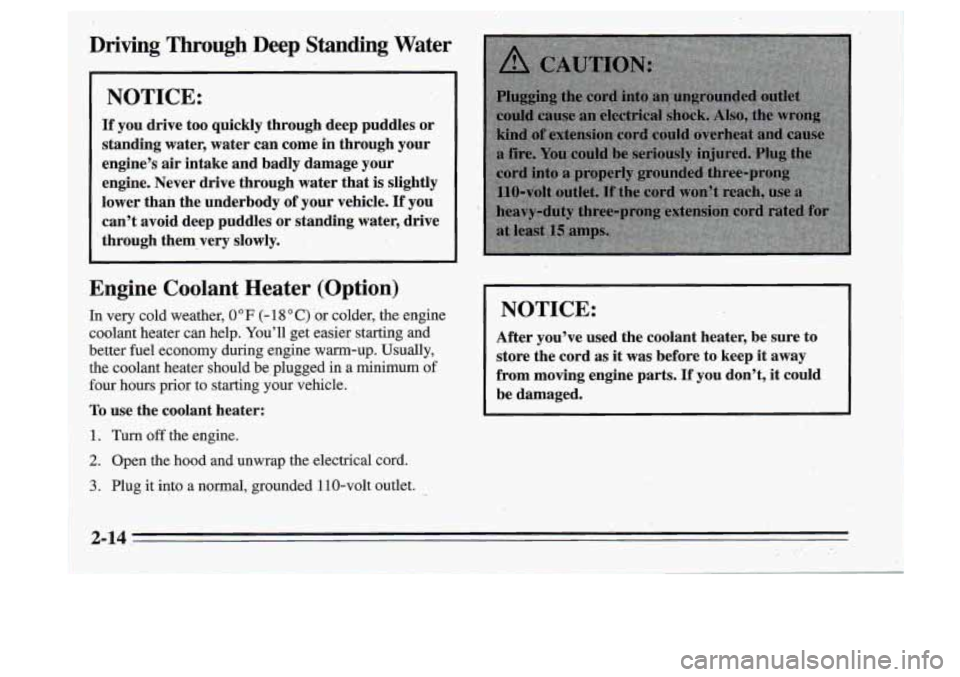
Driving Through Deep Standing Water
NOTICE:
If you drive too quickly through deep puddles or
standing water, water can come
in through your
engine’s air intake and badly damage your
engine. Never drive through water that is slightly
lower than the underbody of your vehicle.
If you
can’t avoid deep puddles or standing water, drive
through them very slowly.
Engine Coolant Heater (Option)
In very cold weather, 0 OF (- 18 O C) or colder, the engine
coolant heater can help. You’ll get easier starting and
better fuel economy during engine warm-up. Usually,
the coolant heater should be plugged in a minimum of
four hours prior to starting your vehicle.
To use the coolant heater:
1. Turn off the engine.
2. Open the hood and unwrap the electrical cord.
NOTICE:
After you’ve used the coolant heater, be sure to
store the cord as it was before to keep
it away
from moving engine parts.
If you don’t, it could
be damaged.
3. Plug it into a normal, grounded 110-volt outlet.
2-14.
’
. ..
Page 73 of 340
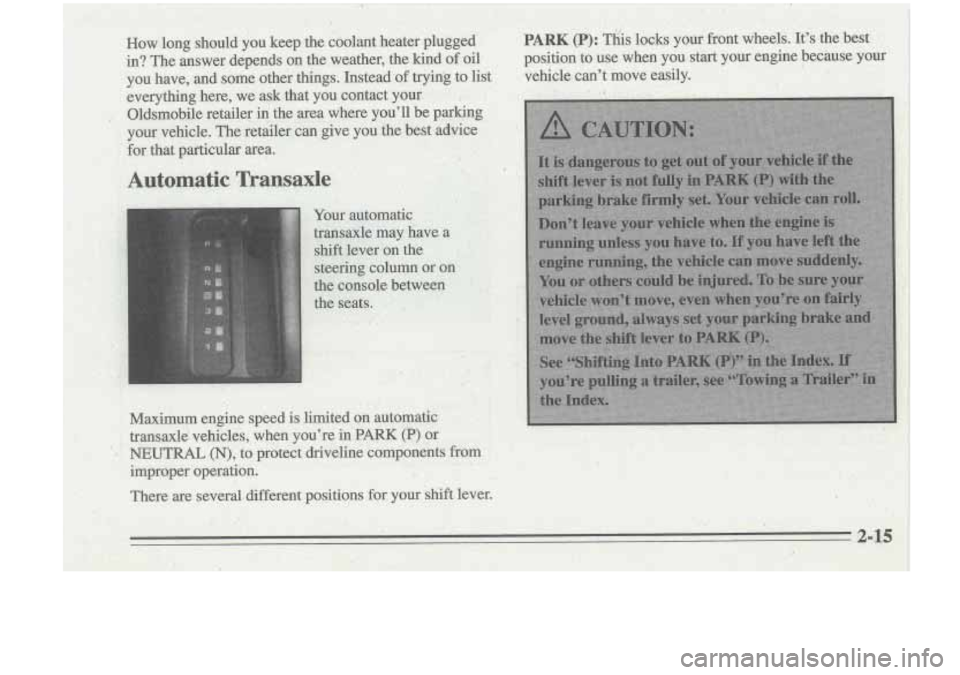
..
,
.r
..
Page 74 of 340
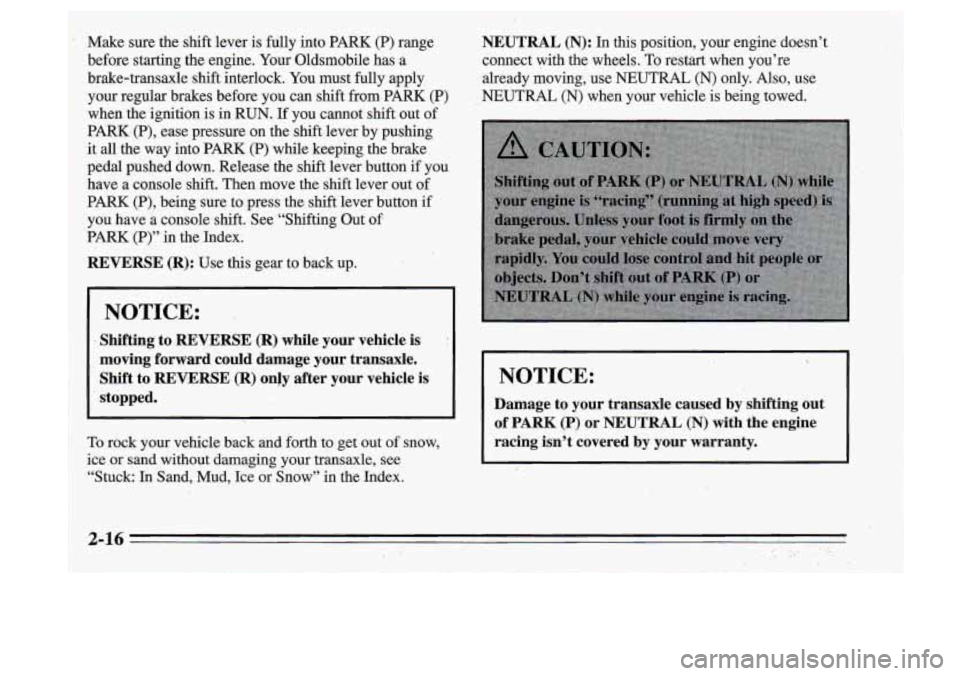
~
~ ~~ ~~~ ~. - ~__~
I!” sure the shift lever
is fully into PARK (P) range
before starting the engine. Your Oldsmobile has a
!brake-transaxle shift interlock. You must fully apply
your regular brakes before you can shift from PARK (P)
Bwhen the ignition is in
RUN. If you cannot shift out of
PARK.(P), ease pressure on the shift lever by pushing
it all the way into PARK (P) while keeping the brake
pedal pushed down. Release the shift lever button
if you
have a console shift. Then move the shift lever out
of
PARK (P), being sure to press the shift lever button if
you have a console shift. See “Shifting Out of
PARK (P)” in the Index.
REVERSE (R): Use this gear to back up.
NOTICE:
Shifting’ to REVERSE (R) while your vehicle is :
moving forward could damage your transaxle.
Shift to REVERSE (R) only after your vehicle
is
stopped.
To rock your vehicle back and forth to get out of snow,
ice or sand without damaging your transaxle, see
“Stuck: In Sand, Mud, Ice or Snow” in the Index.
~ ~~~~
~~~ .
NEUTRAL (N): In this position, your engine doesn’t
connect with the wheels.
To restart when you’re
already moving, use NEUTRAL
(N) only. Also, use
NEUTRAL
(N) when your vehicle is being towed.
I NOTICE:
Damage to your transaxle caused by shifting out
of
PARK (P) or NEUTRAL (N) with the engine
racing isn’t covered by your warranty.
Page 75 of 340

DRIVE (D): This position is for normal driving. It is the
Overdrive position. If you need more power for passing,
and you’re:
- Going less than 35 mph (56 M), push your
accelerator pedal about halfway down.
- Going about 35 mph (56 kmh) or more, push the
accelerator pedal all the way down.
You’ll shift down to the next gear and have more
power.
NOTICE:
If your vehicle seems tb start up rather slowly, or
if it seems not to
shift gears as you go faster,
something
may be wrong with a transaxle system
sensor.
If you drive very far that way, your
vehicle can be damaged.
So, if this happens, have
your vehicle serviced right away. Until then, you
can use SECOND
(2) when you are driving less
than
35 mph (56 km/h) and DRIVE (D) for
higher speeds. THIRD
(3): THIRD (3) is like DRIVE (D),
but you
never
go into Overdrive.
Here are some times you might choose THIRD
(3)
instead of DRIVE (D):
- When driving on hilly, winding roads.
- When towing a trailer, so there is less shifting
- When going down a steep hill.
SECOND
(2): This position gives you more power but
lower fuel economy. You can use SECOND
(2) on hills.
It can help control your speed
as you go down steep
mountain roads, but then you would also want to use
between gears.
lr
brakes off and on.
NOTICE:
Don’t drive in SECOND (2) for more than
5 miles (8 km), or at speeds over 55 mph
(88 km/h), or you can damage your transaxle. Use
DRIVE
@) or THIRD (3) as much aspossible.
Don’t
shift into SECOND (2) unless you are going
slower than
65 mph (105 km/h), or you can
damage your engine.
Page 76 of 340

., ‘
FIRST (1): This position gives you even more power - .
(but lower fuel economy) than SECOND (2). You can
use it on very steep hills,
or in deep. snow or mud. If the
shift lever is put in FIRST (l), the transaxle won’t shift
into first gear until the vehicle is going slowly enough.
..
NOTICE:
If your front wheels can’t rotate, don’t try to
drive. This might ,happen if you were stuck in
very deep sand or mud- or were’up against
a solid
object. Youxould damage your ,transaxle.
Also,
if you stop when going uphill, don’t hold.
your vehicle there with only the accelerator
pedal. This could overheat and damage the
transaxle. Use your brakes.or
shift into PARK (P)
to hold your vehicle in position on a hill.
Parking Brake
The parking brake uses the brakes on the rear wheels.
I To set the parking brake,
hold the regular brake pedal
down with your right foot.
Push down the parking
brake pedal with your left
foot.
To release the parking brake, hold the regular brake pedal
clown with your right foot and push
the parking brake
pd with your left foot. men you lift your left foot, the
parking brake pedal will follow it
to the released position.
NOTICE:
Driving with the parking brake on can cause
your rear brakes
to overheat. You may have to
replace them, and you could also damage ‘other
parts of your vehicle.
Page 77 of 340

If you are towing a trailer and are parking on any hill, Column Shift
see “Towing a Trailer” in’ the Index. That section shows
what to do first to keep the trailer from moving. 1. Hold’the brake pedal down with your right foot and
set the parking brake.
Shifting Into PARK (P) 2. Move the shift lever into PARK (P) position like
2-19
c
Page 78 of 340
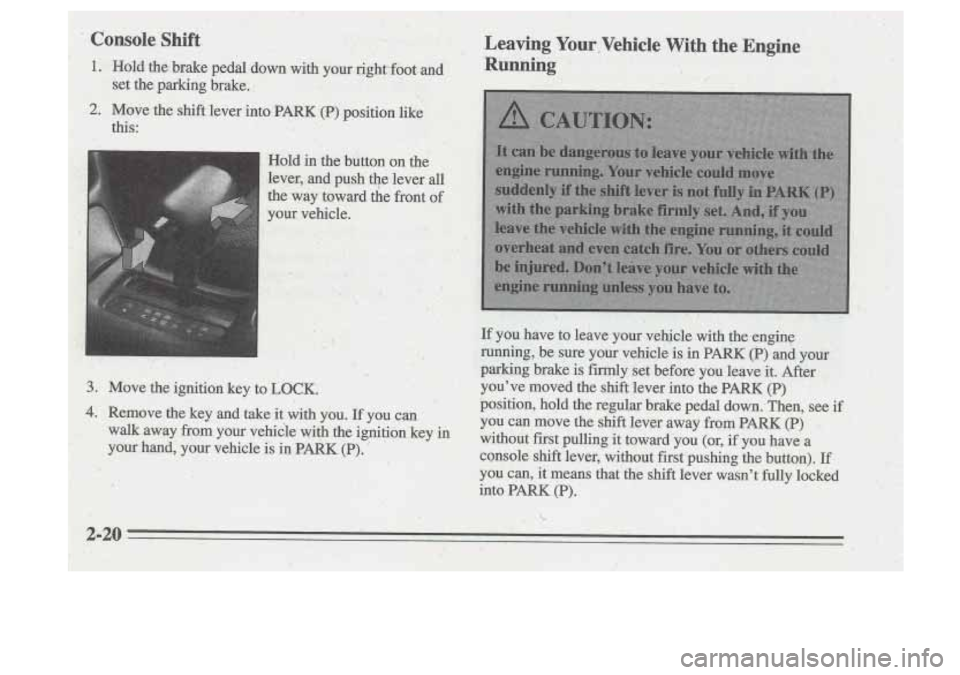
Page 79 of 340
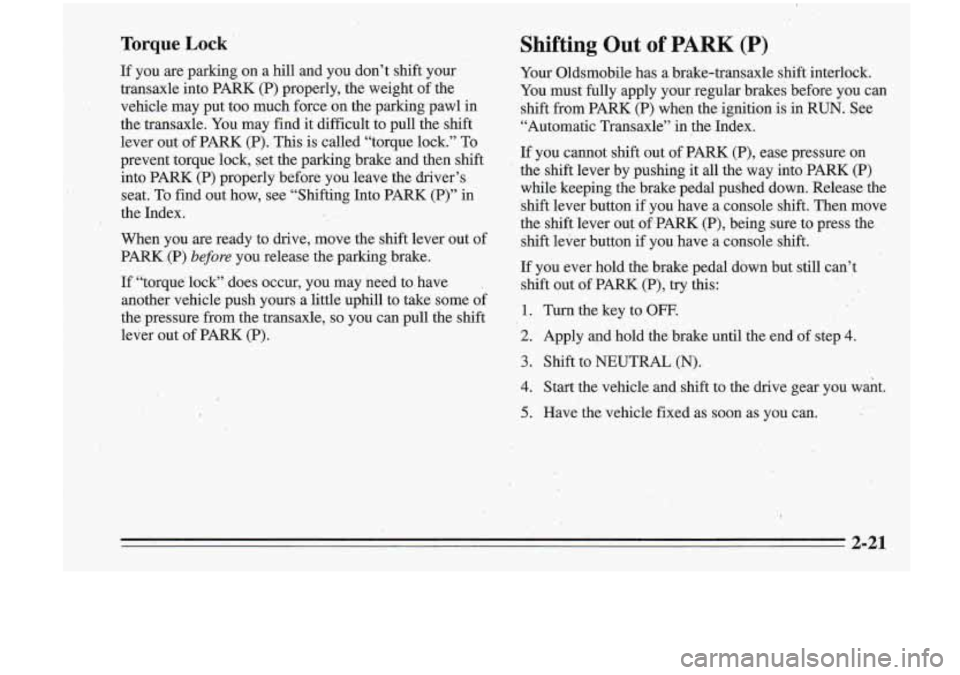
Torque Lock
If you are parking on a hill and you don’t shift your
transaxle into PARK (P) properly, the weight of the
vehicle may put too much force on the parking pawl
in
the transaxle. You may find it difficult to pull the shift
lever out of PARK
(P). This is called “torque lock.” To
prevent torque lock, set the parking brake and then shift
into PARK (P) properly before you 1,eave the driver’s
seat.
To fmd out how, see “Shifting Into PARK (P)” in
the Index.
When you
are ready to drive, move the shift lever out of
PARK (P)
before you release the parking brake.
Shifting Out of PARK (P)
If “torque lock” does occur, you may need to. have ,
another vehicle push yours a little uphill to take some of
the pressdre from the transaxle,
so you can pull the shift .
lever out of PARK (P). Your
Oldsmobile has
a brake-transaxle shift. interlock.
You must fully apply your regular brakes before you can
shift from PARK (P) when the ignition is in RUN. See
“Automatic Transaxle”
in the Index.
If you cannot shift out of
PARK (P), ease pressure on
the shift lever by pushing it all the way into PARK (P)
whil‘e keeping the brake pedal pushed down. Release the
shift lever button if you have a console shift. Then move
the shift lever out
of PARK (P), being sure to press the
shift lever button’
if you have a console shift.
If you ever hold the brake pedal down but still can’t
shift out of PARK (P), try this:
1. Turn the key to OFF.
2. Apply and hold the brake until the end of step 4.
3. Shift to NEUTRAL (N).
4. Start the vehicle and shift to the drive gear you want.
5. Have the vehicle fixed as soon as you can.
2-21
Page 80 of 340
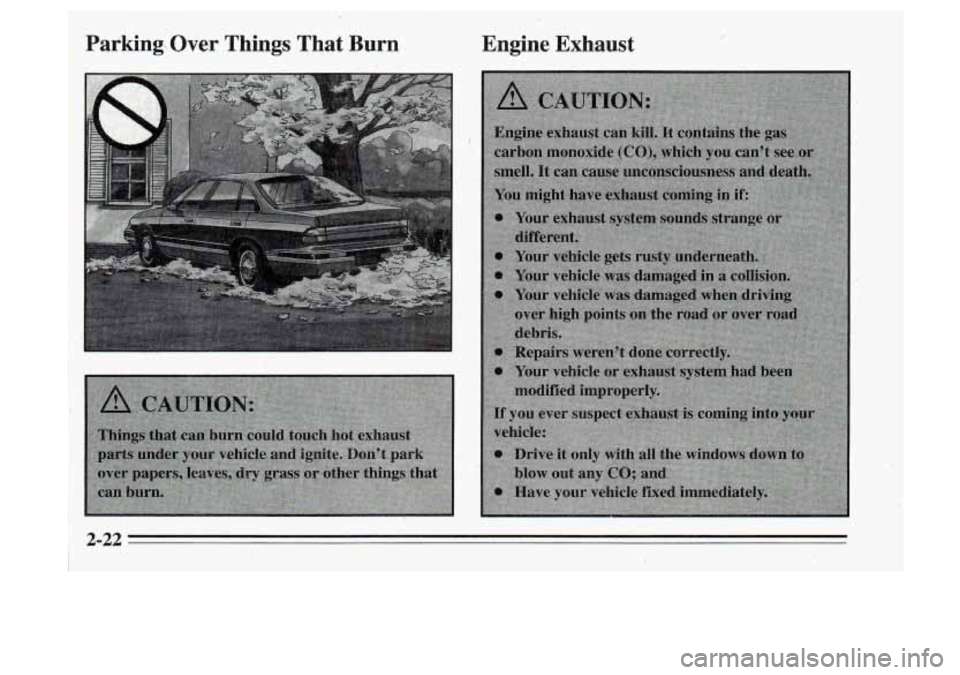
Parking Over Things That Burn
Engine Exhaust
I